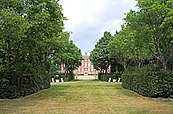Talk:Wilderness (garden history)
Appearance
A fact from Wilderness (garden history) appeared on Wikipedia's Main Page in the Did you know column on 19 January 2022 (check views). The text of the entry was as follows:
|
| This article is rated C-class on Wikipedia's content assessment scale. It is of interest to the following WikiProjects: | |||||||||||
| |||||||||||
Did you know nomination
[edit]- The following is an archived discussion of the DYK nomination of the article below. Please do not modify this page. Subsequent comments should be made on the appropriate discussion page (such as this nomination's talk page, the article's talk page or Wikipedia talk:Did you know), unless there is consensus to re-open the discussion at this page. No further edits should be made to this page.
The result was: promoted by Theleekycauldron (talk) 21:38, 14 January 2022 (UTC)
( )

Ham House wilderness
- ... that in garden history, a wilderness is a highly artificial and formalized type of woodland, forming a section of a large garden? Source: History of Early American Landscape Design, Center for Advanced Study in the Visual Arts, National Gallery of Art (Washington DC). "Wilderness" by Anne L. Helmreich: "When used in the context of 17th-and 18th-century gardens, the term wilderness generally referred to a planned arrangement of trees that contained an understory of vegetation, often set within a regularly defined space ....Elaborately patterned walks helped establish the internal design of the wilderness and encouraged strolling.... Most significantly, a wilderness (unlike a shrubbery) was often arranged in geometrical fashion, with regularized plantings punctuated by a centrally placed decorative object, such as a fountain or statue.

Ham House wilderness
Moved to mainspace by Johnbod (talk). Self-nominated at 23:43, 6 January 2022 (UTC).
 New enough, long enough, within policy. QPQ done. Hook is good, but I would prefer "in the history of gardening". I also think I prefer File:Ham_House_05.JPG as an image at this size. What do you think? Srnec (talk) 01:33, 8 January 2022 (UTC)
New enough, long enough, within policy. QPQ done. Hook is good, but I would prefer "in the history of gardening". I also think I prefer File:Ham_House_05.JPG as an image at this size. What do you think? Srnec (talk) 01:33, 8 January 2022 (UTC)
- I think I prefer the original, but I don't really mind. The new one just comes over as allover green at this size. Johnbod (talk) 03:17, 8 January 2022 (UTC)
- ALT2... that in the history of gardening, a wilderness is a highly artificial and formalized type of woodland, forming a section of a large garden? - same source, mix & match with pics & hooks. Johnbod (talk) 03:15, 8 January 2022 (UTC)
 ALT2 with second pic good to go. (I checked with my wife and she prefers the second pic.) Srnec (talk) 03:56, 8 January 2022 (UTC)
ALT2 with second pic good to go. (I checked with my wife and she prefers the second pic.) Srnec (talk) 03:56, 8 January 2022 (UTC)
- Thanks, but just watch - the 2nd pic won't get chosen for the slot. Johnbod (talk) 14:51, 8 January 2022 (UTC)
- Promoter's comment to @Johnbod: i like peaceful :) theleekycauldron (talk • contribs) (they/she) 21:38, 14 January 2022 (UTC)
- Thanks, but just watch - the 2nd pic won't get chosen for the slot. Johnbod (talk) 14:51, 8 January 2022 (UTC)
ALT2 to T:DYK/P1


